Chess Expeditions: Humor in Chess
By Prof. Christian Hesse

Ultimately chess is just chess - not the best thing in the world
and not the worst thing in the world, but there is nothing quite like it.
– W.C. Fields
Last month's column talked about the game of chess from the perspective of
its invisibility. It touched on varies themes such as playing chess blindfold
or making chess events more spectacular by learning a bit from the design of
big boxing events.
The column triggered a number of interesting and humorous reader reactions.
One reader reminded me of this joke: How do we know that Neanderthal Man played
blindfold chess? Well, in excavations of their sites no chessboards and pieces
have been found.
Regarding the suggestion of taking boxing as a role model, another reader sent
me the following cartoon:
These reader reactions presented the motivation for taking a look at humor
in chess in this month's column.
Chess is a war game and although there may not be much humor in war, there
still is a lot of humor in chess, in the chess world around and even on the
board.
Sigmung Freud, too, has of course dealt with humor. According to his psychoanalytical
theory of humor, formulated in his pathbreaking work Jokes and Their Relation
to the Unconscious, there are only two purposes a joke may serve. It is
either a hostile joke serving the purpose of aggressiveness or it is an obscene
joke serving the purpose of exposure. I, personally, regard this view of reducing
humor to its aggressive or sexual undercurrents as somewhat too narrow and hence
as inadequate to cover all varieties of humor. It certainly doesn't account
for much of the humor that I myself enjoy.
To me the incongruity theory of humor is more convincing. It is even older
than Freud's and goes back to the Scottish poet and essayist James Beatty, who
in 1776 wrote: “Laughter arises from the view of two or more inconsistent, unsuitable
or incongruous parts or circumstances, considered as united in one complex object
or assemblage.” This view is shared by the contemporary anthropologist Elliott
Oring, a professor at California State University in Los Angeles. In his book
Jokes and Their Relation he writes: “The perception of humor depends
on the perception of an appropriate incongruity – that is the perception of
an appropriate interrelationship of elements from domains that are generally
regarded as incongruous.” In other words, in a joke there are always elements
which seemingly don't fit together. Oring has also written a well-received book
about Freud's humor, The Jokes of Sigmund Freud, and claims that Freud's
repertoire of jokes and his view of humor say more about Freud himself than
about humor in general.
Humor is very subtle and much of its Why and How is still not very well understood.
That's why computer-generated humor remains poor for the most part. Here is
an example created by JAPE (Joke Analysis and Production System, a software
designed by Kim Binsted and Graeme Ritchie to create jokes):
“What do you call a breakfast food murderer? A cereal killer.” Cute, but
funny?
I think that the reader's examples given above are covered nicely by the incongruity
theory of humor as well as many items on my
Top 10 list of things to check if you are a chess addict
You know you are a chess addict if
- you bump into someone and mumble J'adoube, and you don't even speak
French;
- you drop everything and quickly spin around if you hear someone say “Hi
Bobby” behind your back;
- you take a chess book to the bathroom and forget to go to the bathroom;
- you have checkered underwear with “It's your move” on the front;
- you end your letters and e-mails with “P.S. 1.e4. Your move!” hoping to
start a game;
- you subtract the sum of boyfriends/girlfriends/husbands/wives you have ever
had from the number of chess programs you have owned and this number is positive;
- you explain that you live one block up and two blocks down, or like a Knight
move;
- you named your first child Judith or Fritz;
- you explain your last relationship didn't work because the two of you were
like bishops of opposite color;
- you read all of this and didn't laugh..
We all know that chess is full of smart and interesting characters and hence
inevitably full of entertaining and humorous stories and anecdotes. A lesser
known one is this: Kasimirz Makarczyk was one of the Polish chess masters who
participated in the Hamburg International Tournament of 1930. One evening Makarczyk
was having dinner in his hotel when another gentleman entered the dining room.
When passing Makarczyk he bowed slightly and said “Mahlzeit” (a German expression
for “Enjoy your meal”). Makarczyk, unable to understand German, stood up quickly
and with a similar bow he responded “Makarczyk”. The same ritual repeated itself
the following evening and the evening after that. Makarczyk, being slightly
irritated by this, inquired whether during the chess tournament if it was the
custom in Germany to introduce oneself at every encounter, and was informed
of the true meaning of “Mahlzeit”. Later that day at dinner time, Makarczyk
decided to take the initiative himself. When he saw the stranger approaching,
he jumped up, bowed slightly and in a most friendly way he said: “Mahlzeit”.The
stranger was taken aback, but after only a brief moment he responded: “Makarczyk”.
Humor in chess is not restricted to the people who play the game but can also
be found on the chessboard. For this variety consider the following diagram:
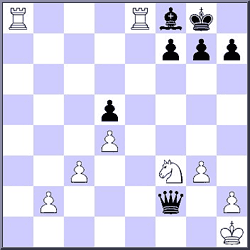
Black to move
In the position displayed, Chess Challenger Voice, built in 1979 as the first
chess computer that could talk, was playing the black side. He could force a
draw with 1… Qxf3+. But he wanted to win at all cost. No winning variation was
at hand, though. So which phenomenal idea did he come up with? Well, in a breathtaking
display of hilarious gamesmanship, he converted the white rook on e8 into a
black rook and with this he played 1…Re1+ while proudly announcing a
mate in impeccable English. It's unknown whether in view of this stroke of genius,
his programmer R.C. Nelson was laughing or crying or anything else.
In 2005 there was a tournament for composers of chess studies and the theme
of this tournament was Humor. The jury for judging the contributed studies
consisted among others of GM Jan Timman. It awarded the first prize to the
following study by 28-year-old composer Sergiy Didukh from a small Ukrainian
village:
S. Didukh, 2005, Humor Tournament

White to move and draw
White is behind in material but has a small threat against Black's king which,
however, is not sufficient for a win, but may be nurtured to secure a draw.
The first idea one might entertain is to try to construct a draw by perpetual
check. This also does not succeed. After 1. Bd6, Black wins with 1… Qc3 2. Re5
Qxe5 3. Bxe5 Rxe5 4. Rxh7+ Kg8 5. Rg7+ Kf8 6. Nxc5 Rd8 7. Nxd7+ Rxd7 8. Rxd7
Ke8.
So what else to do? Salvation for White consists in playing for a stalemate.
He does it in a both mind-boggling and comical way by getting rid of all of
his five pieces and immobilizing his king. 1. Be6 dxe6 2. Bd6 Qc3 3. Nd4!
Obstructs the black queen's view of g7, so that a draw by perpetual checks
becomes possible again. 3…Qxd4 (after the alternative 3…Qd3 4. Be5 Rxe2
5. Rxh7+ Kg8 6. Rg7+ Kf8 7. Bd6+ Ke8 8. Re7+ Kf8 Black also doesn't have more
than a draw and White doesn't have a mate either.) 4. Re5. Again obstructing
the Queen's view of g7.
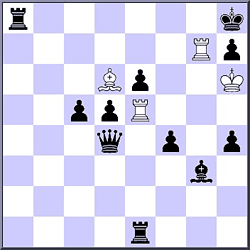
Position after 4. Re5
5…Qd3. The Black Queen must guard h7 either directly or by pinning the
rook g7. 5. Re4 Qc3 (5…Qxe4 allows 6. Be5 f3 7. Rxg3+ Qxe5 8. Rg8+ and
stalemate.) 6. Rd4 Qc2 7. Rd3 Qb2 8. Rc3 Qb1 9. Rc2 Qa1 10. Rb2. After
10. Rc3 there is 10…Ra7!
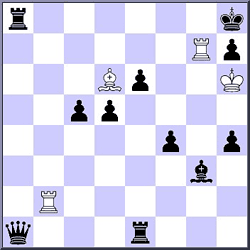
Position after 10. Rb2
10…Qxb2 11. Be5 f3. Here taking on e5 with rook or queen allows 12.
Rg8+ Kxg8 with stalemate and 11…Rf8 12. Rxh7+ Kg8 13. Rg7+ is a draw by perpetual
check. 12. Rxg3+ Rxe5 13. Rg8+ Kxg8 stalemate.
It makes a strong amusing impression the way the black queen and the white
rook dance down the staircase into the south-west corner of the board. [Click
to replay]
For a hilarious endgame in over the board play consider
Lowcki-Tartakower, Jurata, 1937
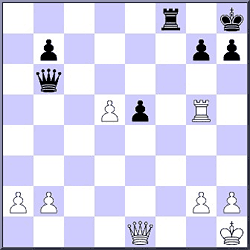
Black to play, position after White's 32. move
In analysing how to proceed, Tartakower discovered the only winning manoeuvre.
What is it?
With this little problem I leave you until next month. Hint: Remember the staircase
theme from the above study by Didukh.
Solution to last month's column Chess: The ultimate invisible game
Kramnik – Topalov, Monaco 2003 (blindfold)
1. e4 c5 2. Nf3 e6 3. d4 cxd4 4. Nxd4 Nc6 5. Nc3 d6 6. Be3 Nf6 7. f4 a6 8. Qf3
Qc7 9. 0-0-0 Bd7 10. Nb3 Rc8 11. Kb1 b5 12. Bd3 Nb4 13. g4 Bc6 14. g5 Nd7 15.
Qf2 g6 16. Rhf1 Bg7 17. f5 Ne5 18. Bb6 Qd7 19. Be2 Qb7 20. Na5 Qb8 21. f6 Bf8
22. a3 Nxc2 23. Kxc2 Bxe4+ 24. Kb3 Ba8 25. Ba7 Qc7 26. Qb6 Qxb6 27. Bxb6 h6
28. Nxb5 Kd7 29. Bd4 Bd5+ 30. Ka4 axb5+ 31. Bxb5+ Bc6
White (Kramnik) now played a fantastic combination starting with 32. Bxe5!
Bxb5+ 33. Kxb5 Rc5+ 34. Kb6 Rxe5 35. Rc1 Rxa5. It looks as
if Topalov may save himself with this device. 36. Rc7+. Kramnik continues
to press for a win. The alternative 36. Kxa5 d5 with 37…Bd6 will let Topalov
escape. 36…Kd8 37. Rfc1 Rc5. It still looks as if Black might survive.
Everything else loses outright: 37…Ra8 after 38. Kb7 and 37…d5 after 38. Kxa5.
But the text move allows 38. T1xc5 dxc5. And now what?
39. Kc6!! Decides the day since there is nothing against Rc7-a7-a8.
1:0. Quite a feat considering that both players played blindfold. [Click
to replay]
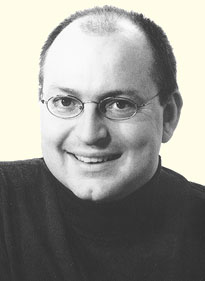 About
the author
About
the author
Christian Hesse holds a Ph.D. from Harvard University and was on the faculty
of the University of California at Berkeley until 1991. Since then he is Professor
of Mathematics at the University of Stuttgart (Germany). Subsequently he has
been a visiting researcher and invited lecturer at universities around the world,
ranging from the Australian National University, Canberra, to the University
of Concepcion, Chile. Recently he authored “Expeditionen
in die Schachwelt” (Expeditions into the world of chess, ISBN 3-935748-14-0),
a collection of about 100 essays that the Viennese newspaper Der Standard
called “one of the most intellectually scintillating and recommendable books
on chess ever written.”
Christian Hesse is married, has a six-year-old daughter and a two-year-old
son. He lives in Mannheim and likes Voltaire's reply to the complaint: ”Life
is hard” – “Compared to what?”.
Previous articles for ChessBase:



















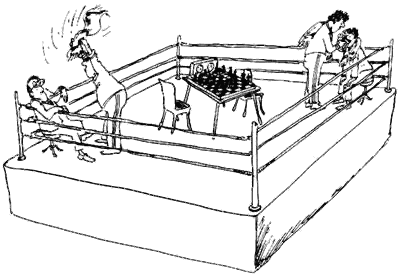






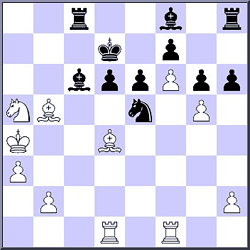

 About
the author
About
the author




